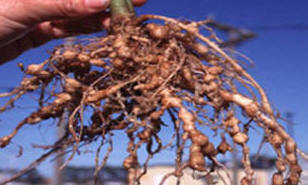Eelworms - Nematodes.
Unexplained damage to foliage and flowers. Chrysanthemum, Phlox, Penstemons, Oenothera, Gypsophyla, Aubretia and bulbs.
Eelworms are a pest, but for practical purposes, they can be treated like an incurable disease of plants.
The Eelworm Nematode is invisible to the human eye - in most cases. It is only the result of their damage that we actually see, and there is no treatment available to the amateur gardener, so best to remove the infected plant and burn. In many instances it also means no planting of the same type of plant in the same area for many years.
The damage from eelworm infestation does not become apparent until late summer and into the autumn, when leaves of various perennials and shrubs mysteriously turn black - and sometimes yellow with no visible reason such as aphids, fungus or anything else that can be blamed!

Experienced horticulturist will shudder at the description just given. Fine. That's how it can best be described to the amateur. Many professionals are also flummoxed as to what has hit their plants as well, so don't worry!
The main recipients of Eelworms are notably Chrysanthemums, Penstemons, Phlox, Gypsophila and Anemones. Strawberries have their own eelworm - or nematode as they are known! (A little bit confusing, because there are also useful Nematodes - often sold as biological control for such things as slugs and leatherjackets etc.)
If ever there is a discoloured or distorted leaf or flower with no obvious signs of pest or disease, then Eelworms must be suspect. On plants where eelworms are known problems, such as Chrysanthemums, then overhead watering should be kept to minimum, because this facilitates the movement of the eelworm on the exterior of the leaf.
Nematodes sometimes cause growth on roots of some plants. Nematodes are also the cause of many parasitic problems on humans and animals - also fish.
Bulb Eelworms
Stem and Bulb eelworm are also responsible for damage to bulbs and corms including Daffodils, Tulips and Hyacinths. the tell tale signs are soft - rotten - bulbs, and small yellowish swellings on the foliage - especially with Tulips. (Not to be confused with Rust.) Again, the control is dig up and burn, and not replant with the same type of bulb in that area for at least four years.
Typical Nematode nodules on Root of plant.
There is a method of hot water treatment for chrysanthemum stools for those wishing to take cuttings from Chrysanthemums - affected plant.
Other than that, remove affected plants and burn. Do not compost.
Best Selling Gardening Products
Popular Gardening Sections

Problems
Identify Weeds in The Garden - How to deal with weeds. Diseases and Pest which harm your garden and plants, learn how to prevent, deter and erradicate your garden problems.
Garden Problems
Pruning
Pruning Guide. Shrubs flower better with correct pruning. Many illustrations and examples of what to do - and when. Includes evergreens, roses, flowering shrubs, spring flowering shrubs and pruning for stem effect. This is our most viewed and comprehensive section,
Pruning
Gardening Businesses
Gardening Businesses listed in the UK counties and USA states. County and State Listings of businesses involved in Garden supplies and services. If you wish to be added to the Directory, please send us your information. Having problems, use the search box
Businesses
Gardening
In this section you will learn about Gardening Basics, Containers, Landscaping, Propagation and Soil.
Gardening
Gardening Gifts
Gardening Gifts and Reviews, Read Before you Buy
- Gardening Gifts Ideas
- Gifts For Her
- Gifts For Men
- Power Tool Gifts
- Cheap Gifts
- Personalised Gifts
- Wildlife Gifts
- Family Gifts



